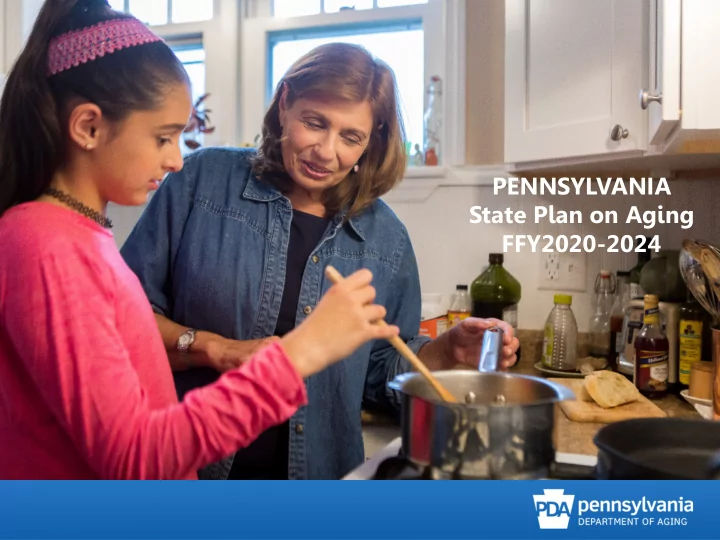

PENNSYLVANIA State Plan on Aging FFY2020-2024
What is the State Plan on Aging? Why must we develop a plan? • Required by Older Americans Act, Section 307(a) • Guidelines provided by Assistant Secretary for Aging, U.S. Department of Human Services, Administration for Community Living (ACL) The State Plan serves several purposes: • Document tangible outcomes planned & achieved • Translate activities into best practices that can help us leverage additional funding • Provides a blueprint for the next four years • Build capacity for long-term care efforts in PA
What goes into the plan? The State Plan on Aging “cover-to-cover”: • Introductory information – Table of contents/Contact info for PDA & AAAs – PDA’s mission, vision, core values & plan goals • Narrative content – Executive Summary – Review of our structure, AAAs, councils & programs – Review of PA demographics, trends, emerging issues in aging – Review of state plan on aging development – Details of PDA goals, objectives, strategies & timelines/measures • Appendices – Intrastate funding formula, required assurances and sign-offs
At the heart of the plan… The Goals, Objectives, Strategies & Measures; guided by the needs of Pennsylvania’s older adults and ACL’s Focus Areas: • ACL Older Americans Act Core Programs (caregiver, nutrition, employment, strengthening network) • ACL Discretionary Grants & Other Funding Sources (Alzheimer’s, health & wellness, age-friendly communities, NWD) • ACL Participant-Directed/Person-Centered Planning (person-centered planning, connecting people to resources) • ACL Elder Justice (protective services, advocacy, ombudsman, legal assistance)
How is the plan developed? Some steps are required, all of them are helpful… • PDA internal strategic planning meeting • Review 2016-20 plan goals and objectives • Review “good things” happening in other states • Receive stakeholder and public input – Stakeholder groups submit recommendations – Community conversation (virtual this year) – Online survey – Conversations like this one • Use Penn State Data Center & other resources • Synthesize a plan that puts PA older adults first
State Plan 2020-24 Goals Goal One: Strengthen aging network’s capacity, promote innovation • and best practices, and build efficiencies to respond to the growing and diversifying aging population. Goal Two: Improve services for older adults and the ability to • advocate for them by using evidence-informed planning, committing to data integrity and being accountable for results. Goal Three: Establish and enhance efforts to support healthy living, • active engagement and a sense of community for all older Pennsylvanians. Goal Four: Emphasize a citizen-first culture that provides outreach, • embraces diversity, and honors individual choice. Goal Five: Advocate for the rights of older adults and ensure their • safety and dignity by raising awareness of and responding effectively to incidences of abuse, injury, exploitation, violence and neglect.
Goal One: Strengthen aging network’s capacity, promote innovation and best practices, and build efficiencies to respond to the growing and diversifying aging population. Objectives: Leverage technology to improve quality and efficiency of aging • services network. Increase the Department’s capacity to serve older adults through • strategic and meaningful partnerships and collaborations. Ensure OAA programs are reaching diverse, LEP and socially isolated • older adults, including LGBT older adults & those living with a disability. Help older adults achieve better quality of life by ensuring those • who seek assistance are connected to supportive programs and services. Support families and friends who are caregivers to enable them to • thrive in their caregiving roles.
Goal Two: Improve services for older adults and the ability to advocate for them by using evidence-informed planning, committing to data integrity and being accountable for results. Objectives: Ensure excellence in service delivery through use of data and • analytics to assess the outcomes, quality and value of services provided to older adults. Ensure that data capture is efficient, compliant, and provides • meaningful information and knowledge.
Goal Three: Establish and enhance efforts to support healthy living, active engagement and a sense of community for all older Pennsylvanians. Objectives: Ensure a network of age and dementia-friendly providers and • communities throughout Pennsylvania. Advance efforts to reduce stigma associated with mental health • disorders and connect older adults with mental healthcare resources. Expand the availability and use of programs that reduce social • isolation. Promote engagement in healthy aging, nutrition, education and • prevention programs.
Goal Four: Emphasize a citizen-first culture that provides outreach, embraces diversity, and honors individual choice. Objectives: Ensure aging services information and resources are accessible, • inclusive, consistent and available through a variety of sources. Build a workforce that prioritizes and is responsive to the needs of • older Pennsylvanians by listening, being inclusive, having empathy and respecting individual choice.
Goal Five: Advocate for the rights of older adults and ensure their safety and dignity by raising awareness of and responding effectively to incidences of abuse, injury, exploitation, violence and neglect. Objectives: Increase effectiveness in responding to elder abuse and protecting • older adults through expanded outreach, enhanced training, innovative practices and strategic collaborations. Increase capacity and expertise in the ability to investigate and • resolve allegations of financial exploitation. Equip older adults, their loved ones, advocates and stakeholders • with information needed to identify and/or prevent abuse, neglect and exploitation, and support them in their ability to exercise their full rights.
How can you participate? • Participate in the online: Community & Stakeholder Survey Available through June 21, 2020 at the following link: Participate in Community & Stakeholder Survey • Join the virtual statewide: Community Conversation to discuss the draft 4-Year State Plan on Aging To be announced next week and held late June
Questions? Thoughts or insights: State Plan project manager: Stephanie Cole stcole@pa.gov 717.772.0193
Recommend
More recommend